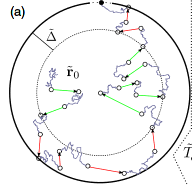AG — Prof. Heiko Rieger — Statistical Physics
Optimality of spatially inhomogeneous search strategies
Heiko Rieger, Karsten Schwarz Yannick Schröder

We consider intermittent search processes, which alternate stochastically between slow, diffusive motion in which the target can be detected and fast ballistic motion during which targets cannot be detected. The distribution function of ballistic motion directions varies from point to point in space. The specific space dependence of this distribution together with the switching rates between the two modes of motion establishes a spatially inhomogeneous search strategy. We show that the mean first passage times for several standard search problems -- narrow escape, reaction partner finding, reaction-escape -- can be minimized with a directional distribution that is reminiscent of the spatial organization of the cytoskeleton filaments of cells with a centrosome: radial ballistic transport from center to periphery and back, and ballistic transport in random directions within a concentric shell of thickness Δopt along the domain boundary.
The successful usage of efficient search and transport strategies is one of the most important needs in biology and human behavior. It can be observed on all length scales of life and in all kinds of complexity. Thus, there are a lot studies on search strategies for different (especially for markovian) searchers, like for example persistent random walks, Levy walks and intermittent search strategies. However, most of these studies assume a homogeneous search strategy and/or a homogeneous target distribution within the search domain. For real search processes, these assumptions are not always true. A prominent counter-example, in which we are interested, is innercellular cargo transport along the cytoskeleton. The targets are not equally distributed (often a certain region at the membran) and the motor protein based cargo transport along the cytoskeleton filaments is non-isotropic, as the cytoskeleton is a non-isotropic network in cells with a centrosome. We study for the first time the efficiency of intermittent search strategies, in which the distribution function of ballistic motion directions models this spatial organisation of the cytoskeleton. The results suggest that living cells realize efficient search strategies for various intracellular transport problems economically through a spatial cytoskeleton organization that involves radial microtubules in the central region and only a narrow actin cortex rather than a cell body filled with randomly oriented actin filaments.
| Optimality of spatially inhomogeneous search strategies |
|
| Phys. Rev. Lett. 117, 068101 (2016) | [pdf] |
| Numerical analysis of homogeneous and inhomogeneous intermittent search strategies |
|
| Phys. Rev E. 94, 042133 (2016) | [pdf], [arXiv] |
Legal notice (Impressum) Privacy policy



